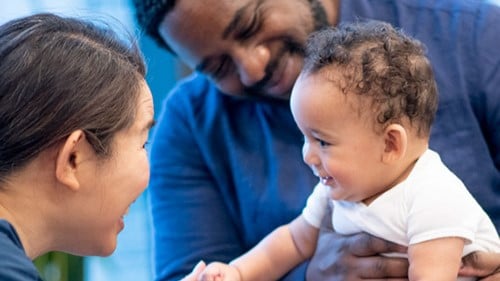At a glance
States, communities, programs, and emergency responders can help ensure health for all is included in their emergency preparedness and response efforts with families with young children.

Health for all
Everyone should have the opportunity to be as healthy as possible. When policies, programs, and systems support health for all people, poor health outcomes can be reduced, health disparities can be prevented, and the whole of society benefits.
Disaster preparedness and relief personnel may encounter individuals who have experienced inadequate access to health services. Providing accessible care to families throughout emergency preparedness, response, and recovery efforts may help minimize health disparities during and following an emergency.
In particular, families with young children and pregnant and lactating women may have unique situations that require special considerations during emergencies. Emergency preparedness and response teams can take action to help achieve access to health services when working with these families.
General preparedness and relief efforts
- Avoid generalizing about a community:
- Population groups are not all alike in their health and living circumstances.
- Race and ethnicity does not represent someone's socioeconomic status, and vice versa.
- Communities vary with history, culture, norms, attitudes, behaviors, lived experience, and many other factors.
- Policies and implementation strategies for disaster relief that recognize and respect the diversity of the community are important. Consider the unique needs of the families affected by the emergency when developing interventions and communication strategies.
- Community engagement efforts can help strengthen cross-sector partnerships, ensure culturally and linguistically appropriate practices, include culturally appropriate community partners, build trust within communities, and promote social connection.
- Continue providing families with disability services before, during, and after public health emergencies. Ensure equal access to public health services for people with disabilities.
- Not every family is the same, and some children are not being raised by their biological parents. Build flexibility into community guidance and public health communications to allow full participation for all caregivers.
- Ask open-ended questions such as "How have you been feeding your baby?" rather than questions that can be answered with yes or no, such as "Are you breastfeeding your baby?"
- Some people have experienced violence, abuse, and trauma, which can impact infant feeding practices. It is important to provide these families with qualified trauma-informed care, as well as access to privacy as needed. Hands-off lactation assistance may be preferred.
Continue providing families with disability services before, during, and after public health emergencies. Ensure accessibility to public health services for people with disabilities.
Community engagement efforts can help strengthen cross-sector partnerships, ensure culturally and linguistically appropriate practices, include community partners, build trust within communities, and promote social connection.
Language
Use non-stigmatizing, bias-free language. Consider the following when responding to emergencies:
- Use person-first language. For example, use "people experiencing homelessness" instead of "the homeless" and "person with diabetes" instead of "diabetic."
- Do not refer to people as their race and ethnicity, for example Blacks, Hispanics, Latinos, Whites. Preferred terms for specific racial and ethnic groups are:
- American Indian or Alaska Native people (identify by specific tribal affiliations when possible).
- Asian people.
- Black or African American people.
- Hispanic or Latino people.
- Native Hawaiian or other Pacific Islander people.
- White people.
- People who identify with more than one race or ethnicity: people of more than one race and ethnicity.
- Ask which terms are preferred by the people being supported.
- Some families may have other preferred terminology for how they feed their babies, such as "nursing."
- See preferred terms for select population groups and communities.
Health for all resources
CDC offers resources to help health departments with their strategic planning to strengthen public health preparedness capabilities. A few key resources include:
Access and Functional Needs Toolkit
Framework to organize planning for broad groups of people with disabilities and others with access and functional needs, recommended action steps, and noteworthy practices from the field.
Community Assessment for Public Health Emergency Response (CASPER)
Helps local, state, regional, or federal officials conduct a rapid needs assessment before or following an emergency. The assessment helps determine the health status, basic needsr of a community in a quick and low-cost manner. It can also be used to assess knowledge, attitudes, and practices of a community.
Disability and Health Emergency Preparedness
Resources for public health professionals, emergency personnel, and communities to create emergency preparedness and response plans that are inclusive of people with disabilities.
Planning for an Emergency: Strategies for Identifying and Engaging At-Risk Groups
Examples of approaches and tools that can help emergency managers identify, plan for, and assist at-risk populations.
Guiding Principles for Inclusive Communication
Helps public health professionals, particularly health communicators, ensure their communication products and strategies adapt to the specific cultural, linguistic, environmental, and historical situation of each population or audience of focus.
